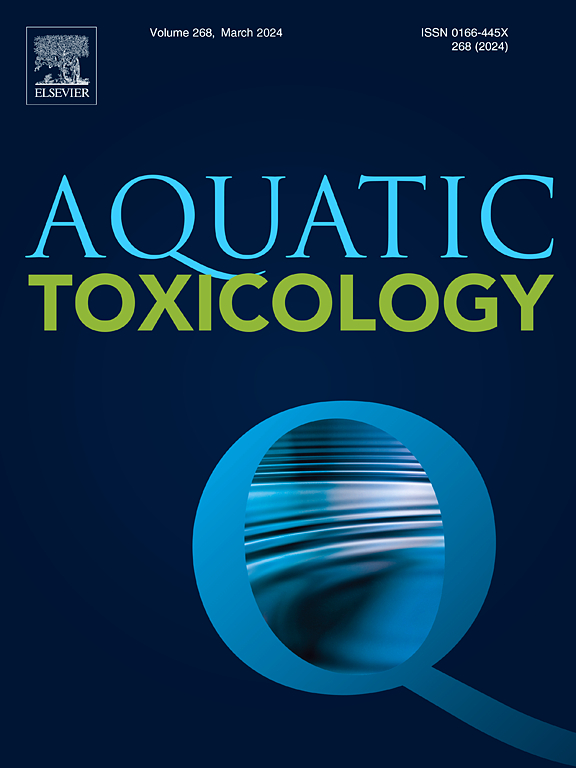Interactive effects of nitrite and bifenthrin on bioaccumulation, oxidative stress and immune responses of Haliotis discus hannai
IF 4.1
2区 环境科学与生态学
Q1 MARINE & FRESHWATER BIOLOGY
引用次数: 0
Abstract
Nitrite (NO2−) and bifenthrin (BF), common environmental pollutant, have been proven to perform toxic effects on marine organisms. To have a better understanding of their effects on marine organism, Haliotis discus hannai was exposed to 0.1 mg/L NO2− and/or 10 μg/L BF for 28 days. The results showed that the gills in direct contact with the water environment exhibited the highest levels of BF bioaccumulation (89.37–142.36 μg/kg), especially after NO2− exposure (P < 0.05). Transcriptome analysis of gills showed that significant enrichments were observed in metabolic, signaling and immune pathways after exposure, such as cGMP-PKG signaling pathway. Additionally, superoxide dismutase (SOD) activity was decreased in gills after exposure to NO2− and/or BF, parallel with the increase in catalase (CAT) activity, malondialdehyde (MDA) content, and total antioxidant capacity (AOC). Regarding genes related to immune, the expression of Defensin was significantly decreased while the expressions of B-cell lymphoma-2 (Bcl-2), Tumor Necrosis Factor-α (TNF-α) and Caspase3 were increased. These results suggested that NO2− and BF exposure disrupted metabolic processes, impaired immune function, and dysregulated antioxidant defenses in the gills of abalone. Particularly, significant alterations were observed under the combined stress of NO2− and BF. In hemocytes, the ROS production could be induced by NO2− and/or BF stress, and the number of hemocytes and phagocytosis decreased significantly, especially in NO2− and BF groups. Integrated biomarker response (IBR) analysis proved that NO2− and/or BF exposure detrimentally affected the overall fitness of abalone, and combined NO2− and BF stress was the most stressful condition. This study emphasizes the impact of NO2− and/or BF on the abalone to better elucidate the risk of environmental pollution on abalone.

亚硝酸盐和联苯菊酯对银盘藻生物蓄积、氧化应激和免疫应答的交互作用
亚硝酸盐(NO2−)和联苯菊酯(BF)是常见的环境污染物,已被证明对海洋生物具有毒性作用。为了更好地了解它们对海洋生物的影响,将盘藻暴露于0.1 mg/L NO2−和/或10 μg/L BF中28天。结果表明,与水环境直接接触的鱼鳃中BF生物积累量最高(89.37 ~ 142.36 μg/kg),特别是暴露于NO2−后(P <;0.05)。对鳃的转录组分析显示,暴露后代谢、信号通路和免疫通路显著富集,如cGMP-PKG信号通路。此外,暴露于NO2−和/或BF后,鱼鳃超氧化物歧化酶(SOD)活性降低,过氧化氢酶(CAT)活性、丙二醛(MDA)含量和总抗氧化能力(AOC)升高。免疫相关基因中,Defensin表达显著降低,b细胞淋巴瘤-2 (Bcl-2)、肿瘤坏死因子-α (TNF-α)、Caspase3表达升高。这些结果表明,NO2−和BF暴露破坏了鲍鱼的代谢过程,损害了免疫功能,并失调了鳃的抗氧化防御。特别是,在NO2−和BF的联合应力下,观察到显著的变化。在血细胞中,NO2−和/或BF应激均可诱导ROS的产生,且血细胞数量和吞噬能力显著降低,尤其是NO2−和BF组。综合生物标志物反应(IBR)分析证明,NO2−和/或BF暴露对鲍鱼的整体适应性有不利影响,其中NO2−和BF联合暴露是最不利的条件。本研究强调NO2−和/或BF对鲍鱼的影响,以更好地阐明环境污染对鲍鱼的风险。
本文章由计算机程序翻译,如有差异,请以英文原文为准。
求助全文
约1分钟内获得全文
求助全文
来源期刊

Aquatic Toxicology
环境科学-毒理学
CiteScore
7.10
自引率
4.40%
发文量
250
审稿时长
56 days
期刊介绍:
Aquatic Toxicology publishes significant contributions that increase the understanding of the impact of harmful substances (including natural and synthetic chemicals) on aquatic organisms and ecosystems.
Aquatic Toxicology considers both laboratory and field studies with a focus on marine/ freshwater environments. We strive to attract high quality original scientific papers, critical reviews and expert opinion papers in the following areas: Effects of harmful substances on molecular, cellular, sub-organismal, organismal, population, community, and ecosystem level; Toxic Mechanisms; Genetic disturbances, transgenerational effects, behavioral and adaptive responses; Impacts of harmful substances on structure, function of and services provided by aquatic ecosystems; Mixture toxicity assessment; Statistical approaches to predict exposure to and hazards of contaminants
The journal also considers manuscripts in other areas, such as the development of innovative concepts, approaches, and methodologies, which promote the wider application of toxicological datasets to the protection of aquatic environments and inform ecological risk assessments and decision making by relevant authorities.
 求助内容:
求助内容: 应助结果提醒方式:
应助结果提醒方式:


